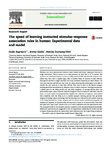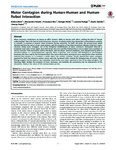Decoding Music-Evoked Emotions in the Auditory and Motor Cortex
Date
2021-03-31Author
Subject
Metadata
Show full item recordAbstract
<jats:title>Abstract</jats:title> <jats:p>Music can induce strong subjective experience of emotions, but it is debated whether these responses engage the same neural circuits as emotions elicited by biologically significant events. We examined the functional neural basis of music-induced emotions in a large sample (n = 102) of subjects who listened to emotionally engaging (happy, sad, fearful, and tender) pieces of instrumental music while their hemodynamic brain activity was measured with functional magnetic resonance imaging (fMRI). Ratings of the four categorical emotions and liking were used to predict hemodynamic responses in general linear model (GLM) analysis of the fMRI data. Multivariate pattern analysis (MVPA) was used to reveal discrete neural signatures of the four categories of music-induced emotions. To map neural circuits governing non-musical emotions, the subjects were scanned while viewing short emotionally evocative film clips. The GLM revealed that most emotions were associated with activity in the auditory, somatosensory, and motor cortices, cingulate gyrus, insula, and precuneus. Fear and liking also engaged the amygdala. In contrast, the film clips strongly activated limbic and cortical regions implicated in emotional processing. MVPA revealed that activity in the auditory cortex and primary motor cortices reliably discriminated the emotion categories. Our results indicate that different music-induced basic emotions have distinct representations in regions supporting auditory processing, motor control, and interoception but do not strongly rely on limbic and medial prefrontal regions critical for emotions with survival value.</jats:p>
Collections
Publisher
Place of Publication
Journal
Volume
Issue
Pagination
Author URL
Recommended, similar items
The following license files are associated with this item:
Related items
Showing items related by title, author, creator and subject.
-
Excitotoxic lesions of the perirhinal cortex leave intact rats’ gustatory sensory preconditioning
Robinson, J; Jones, Peter; Whitt, EJ (RoutledgeEngland, 2021-11-02)<jats:p> We report findings from two sensory preconditioning experiments in which rats consumed two flavoured solutions, each with two gustatory components (AX and BY), composed of sweet, bitter, salt, and acid elements. ... -
The speed of learning instructed stimulus-response association rules in human: Experimental data and model
Bugmann, Guido; Goslin, Jeremy; Duchamp-Viret, P (Elsevier BVNetherlands, 2013-11)Humans can learn associations between visual stimuli and motor responses from just a single instruction. This is known to be a fast process, but how fast is it? To answer this question, we asked participants to learn a ... -
Motor contagion during human-human and human-robot interaction.
Bisio, A; Sciutti, A; Nori, F; Metta, G; Fadiga, L; Sandini, G; Pozzo, T (United States, 2014)Motor resonance mechanisms are known to affect humans' ability to interact with others, yielding the kind of "mutual understanding" that is the basis of social interaction. However, it remains unclear how the partner's ...




